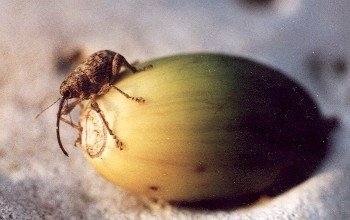Weevils
by Valerie (October 29, 2002)
|
Within the order Coleoptera, or beetles, the weevils constitute a most interesting group. Also called snout beetles, weevils are characterized by having an elongated, downwards curving snout. Many weevils are serious pests of crops, seeds, and plants.
A much less destructive weevil is pictured at right. The acorn weevil is a beautiful little insect with a long, gracefully curved snout. They appear in late summer when the live oak acorns on a tree in our yard are ripe. The adults feed on the acorns by drilling a small hole into the fleshy part of the seed using rasping mouthparts on the end of their long proboscis. The female beetles lay their eggs inside a feeding hole, where the grubs eventually will hatch and eat the pulp of the acorn.
The final insect shown here is an oak leaf roll weevil. It is a robust, stout beetle, with a shiny porcelain-like finish to it's wing covers. The attractive red and black coloration makes the weevil easy to identify, even though we rarely see them. These weevils spend most of their time in the canopy of our largest live oak trees. The female lays a single egg on a young oak leaf, then scores and rolls it up to protect the contents. These leaf rolls are then severed from their attachment to the branch and they fall to the ground. I've found dozens of them on our back deck and carefully unrolled a couple that were fresh. They are very well constructed and most people can't do as well rolling up a sleeping bag. The end of the leaf is even tucked in so that it will not unroll and it takes some persistence to actually unroll one completely. Once the rolls have aged a couple days, if the weather is dry, the leaf dries into a hard casing around the egg. When it hatches, the weevil grub will eat the leaf and possibly even pupate within the roll.
|
 Most weevils are very tiny, but the first pictured here is the largest I've ever seen. It is an agave beetle and is playing dead because I disturbed it. Although large for a weevil, it is still only a bit over ½ inch long. These weevils burrow into the base of the large mescal agaves, or century plants, and lay eggs. The first sign of a problem occurs when the whole plant starts to wilt. By then it is too late and the entire agave must be removed, as the core is dead. The combination of the insects and bacteria that they introduce rots out the large center of the plant, but the leaves don't die for months because of their fleshy reserves. We lost three enormous plants to the weevils and will probably lose the last one as I don't use many pesticides, which would be needed to kill the remaining beetles and larvae that are in the surrounding soil. However, they do not seem to attack young plants and so may run out of food when the bigger plants are all gone.
Most weevils are very tiny, but the first pictured here is the largest I've ever seen. It is an agave beetle and is playing dead because I disturbed it. Although large for a weevil, it is still only a bit over ½ inch long. These weevils burrow into the base of the large mescal agaves, or century plants, and lay eggs. The first sign of a problem occurs when the whole plant starts to wilt. By then it is too late and the entire agave must be removed, as the core is dead. The combination of the insects and bacteria that they introduce rots out the large center of the plant, but the leaves don't die for months because of their fleshy reserves. We lost three enormous plants to the weevils and will probably lose the last one as I don't use many pesticides, which would be needed to kill the remaining beetles and larvae that are in the surrounding soil. However, they do not seem to attack young plants and so may run out of food when the bigger plants are all gone.


 There is an interesting twist to this weevil's life history. Another species of weevil, which is tinier and bright blue in color, also lays its eggs within the oak leaf roll weevil's handiwork. When the tiny blue weevil's egg hatches, the larva feasts on the oak leaf roll weevil grub, in a most un-weevil-like display of parasitism. I've only seen the little blue weevil once, but it's color made quite an impression, especially knowing the implications of finding that species beneath our oak trees.
There is an interesting twist to this weevil's life history. Another species of weevil, which is tinier and bright blue in color, also lays its eggs within the oak leaf roll weevil's handiwork. When the tiny blue weevil's egg hatches, the larva feasts on the oak leaf roll weevil grub, in a most un-weevil-like display of parasitism. I've only seen the little blue weevil once, but it's color made quite an impression, especially knowing the implications of finding that species beneath our oak trees.